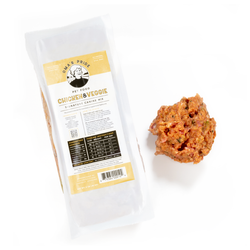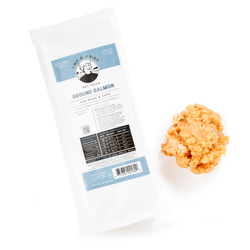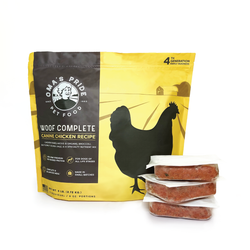The Effect of Nutrition on Your Dog’s Behavior
As a dog trainer and behaviorist, I often get asked, “How does what I feed my dog affect his behavior? Is there a connection between diet and behavior?”
What I think a lot of owners don’t realize is that dog health and dog behavior are so closely related.
To properly answer these questions, we must first understand the role of the gut and nutrients in behavior. So, allow me to attempt my best Ms. Frizzle, and take you on a magic school bus ride.

Cranial nerves, parasympathetic nervous system, and the gut
To start, cranial nerves connect our brains to other systems in our body for primary functions. The Vagus Nerve is the largest of the 12 cranial nerves and is the main nerve in our parasympathetic nervous system, which regulates our digestion, heart rate, and immune system.
Our parasympathetic nervous system also controls our mood, how well we deal with stress, and our ability to get calm and stay calm. The Vagus Nerve is sometimes called the gut-brain axis because it has a bi-directional communication system between the brain and the gut1,2.
The railroad analogy
Think of the connection between the brain and gut as a two-way railroad. At one end of the line is the brain, and at the other end is the gut. In between the two ends, there are many stops at other organs along the way. The “passengers” of this railway system are the neurotransmitters with an extensive range of signals; they all make stops to various organ systems along the route.
One significant passenger is serotonin, a neurotransmitter whose production is primarily orchestrated in the gut’s intestinal tract. Serotonin, which you may have heard referred to as the “happy hormone,” helps achieve feelings of relaxation, happiness, and optimism and reduces depression. Commercial drugs known as SSRIs are prescribed to help patients deal with anxiety and depression by making more serotonin available to brain cells.3
Now, think of the food that is digested as the maintenance system of the railroad. The food ingested can either:
- Keep the gut happy and create more serotonin or
- Cause inflammation or dysbiosis, which is an imbalance of the microorganisms in the gut that play a key role in serotonin production.
In other words, high-quality food keeps the body happy, the train moving, serotonin levels high, and mood elevated. On the other hand, low-quality food can disrupt the train’s ease of movement, disrupting the gut microbiome, decreasing serotonin levels, and thus decreasing mood stability.
Nutrient quality in fresh food versus processed food
Moving forward, how do we know that fresh, minimally processed food is better than dry, commercial kibble?
First, kibble is made through a process called extrusion, which is characterized by multiple steps of cooking at extremely high temperatures. High temperatures denature and burn off many of the nutrients found in the ingredients of the food that are essential for canine well-being. Without these high-quality nutrients, our pets’ behavior can be negatively affected.
Next, to better understand the contrast between kibble and fresh food, let’s explore some key elements in our dogs’ diets that can directly impact their health and mood.


1. Probiotics
First are probiotics, or the good bacteria that help keep the gut happy. Certain strains, like B. longum and L. rhamnosus, have been studied for their positive effects on mood stability and stress coping.5,6 A study done in 2011 showed both rats and humans were better able to deal with stress when put on a daily regimen of probiotics.7
An interesting study conducted at the University of Oregon8 looked at bacteria found in stool samples from 31 dogs rescued from a dog fighting organization. Twenty-one of these dogs were exhibiting some sort of aggressive behavior.
When studied, they found a correlation between certain bacterial strains in the stool sample and an increase in aggressive tendencies. Furthermore, when the aggressive dogs were given other specific strains of probiotics, the aggressive tendencies lessened.
Overall, feeding fresher, minimally processed foods creates a wider variety of these beneficial bacteria. Better beneficial bacteria can positively affect mood, stability, stress coping, lessening aggression, and more. Foods like mushrooms and kefir are also loaded with naturally occurring prebiotics and probiotics.4
2. Butyrate
Another nutrient to consider is butyrate, a fatty acid found in cheese, other dairy products, and fermented foods.
Butyrate is found to have antidepressant effects on rats, thus stabilizing mood.9 In 2017, Sandri et al.10 took a small sample of dogs fed a commercial kibble diet, and dogs fed a fresh meat-based diet and found that meat diets contained a wider variety of beneficial gut bacteria AND butyrate. Gamma-aminobutyric acid, or GABA, also helps the body deal with stress and enter a more relaxed state quicker, and is much higher in raw dog food diets.11
3. Vitamins B5 and B6
Fresh foods also contain bioavailable Vitamin B5 and B6. Vitamin B5, known as the anti-stress vitamin, helps the body cope after stressful events. Vitamin B6 is also essential for mood stabilization as it converts tryptophan into serotonin. If you remember, serotonin is a feel-good hormone that primarily gets made in the gut!
Kibble doesn’t have naturally occurring vitamins due to extrusion. Instead, companies add synthetic vitamins on top of the extruded food. However, improper storage and long shelf life tend to denature these vitamins. While these vitamin packs may meet AAFCO standards, they are less bioavailable than vitamins in whole food sources as they lack co-factors that aid in absorption.12

4. Omega-3 and omega-6 fatty acids
Another nutrient that gets lost in kibble processing and storage of food at room temperature are omega-3 fatty acids such as DHA and EPA.13 Omegas are not only great for brain, heart, and eye development, but Re et al. found a correlation between low omega-3 levels and heightened aggression.14
Though it is not agreed upon what the IDEAL ratio of omega 6s to omega 3s is, Simopoulos found that ratios more than 10:1 (omega 6: omega 3) had adverse effects on chronic inflammatory diseases.15 This is important because our mood is less stable when we aren’t feeling well physically. Commercial dog foods usually contain something closer to a 20:1 or as high as a 50:1 ratio!
Just like humans, if dogs are not feeling well, inflamed, or not at 100%, it will negatively impact their mood stability.
5. Carbohydrate overload
The last nutrient to cover is actually found in excess in commercial dog food—carbohydrates.
Unfortunately, it is hard to tell the percentage of carbohydrates in kibble because you have to do some sneaky math. Most kibbles will have 35-50% carbohydrates. Here’s a quick formula for you:
100 – (protein % + fat % + moisture % + ash % + fiber %) = carbohydrate %
In 1987, Mugford investigated different diets and their effects on the behavior of a group of Golden Retrievers. They found that dogs fed high-carbohydrate diets displayed more active and excitable behaviors, while dogs fed a high-protein diet were calmer and more relaxed.16
Furthermore, many kibbles are made with high-glycemic carbohydrates such as corn, white rice, and potatoes that spike blood sugar quickly. If dogs eat foods high on the glycemic index, we can see huge bursts of energy that, when not channeled correctly, can lead to hyperactivity or destructive behaviors.
Food suggestions for a happy, healthy dog
Now that you understand more about the connection between the gut, diet, and mood, let’s talk about what foods we can give our dogs to result in a better mood and behavior.
Foods high in vitamin B5. This vitamin is also known as the “anti-stress” vitamin because it helps the body regulate and cope with stress. It is also known as an adaptogen, allowing the body to adapt to stressors and restore balance. Foods that contain high amounts of B5 include organ meats (especially liver and kidney), dark meat chicken and turkey, salmon, tuna, egg yolks, milk, cheese, yogurt, broccoli, sweet potatoes, and sun-dried tomatoes.
Foods rich in probiotics like yogurt, kefir, and fermented veggies. Kefir may contain up to 61 strains of beneficial bacteria. Some argue that yogurt doesn’t contain enough probiotics, and some pets might be intolerant to dairy products. Still, it also contains calcium, multiple types of vitamin B, and CLA, an omega-3 fatty acid known for its cancer-fighting properties. When shopping at the grocery store, choose organic and unflavored products for best results.
Foods high in vitamin B6. This vitamin plays a crucial role in neurotransmitter synthesis, thus regulating mood and, ultimately, your dog's behavior. Foods include chicken, turkey, fish, lean cuts of beef and pork, avocado, and leafy greens.
Foods high in vitamin C. This vitamin lowers cortisol levels; cortisol is known as the stress hormone. Foods to include for their vitamin C volume include citrus fruits, strawberries, blueberries, raspberries, bell peppers, papaya, tomatoes, leafy greens, broccoli, brussels sprouts, and cauliflower.
Explore Products
Foods high in magnesium. Magnesium supports healthy sleep, which is important for the body to heal and return to homeostasis. Magnesium is also proven to affect mood by regulating neurotransmitters, regulating cortisol levels, and reducing inflammation. Foods high in magnesium include fish, organ meats, bone meal, spinach, cucumber, peas, and pumpkin.
Foods high in tryptophan. Tryptophan is a precursor to serotonin, which ultimately increases serotonin levels. Foods include turkey, lamb, bananas (avoid when too brown as they have a higher sugar content), canned tuna (in water), chicken, and eggs.
Foods high in vitamin C. This vitamin lowers cortisol levels; cortisol is known as the stress hormone. Foods to include for their vitamin C volume include citrus fruits, strawberries, blueberries, raspberries, bell peppers, papaya, tomatoes, leafy
Add in mushrooms. There are many benefits mushrooms can offer. The reishi mushroom specifically increases the diversity of gut bacteria, which improves the production of serotonin. Boil mushrooms to make mushroom tea, add mushrooms when boiling bones to make bone broth, or sautee and add to your dog’s bowl.
Add chamomile or Ashwagandha Boil (and allow to cool!) some chamomile or Ashwagandha tea for their calming adaptogenic effects.
As you can see, there are many benefits to a fresher, minimally processed diet. And the best part is that there are so many foods to explore that every dog is bound to find something they love!
References
- Breit, S. Vagus Nerve as Modulator of the Brain–Gut Axis in Psychiatric and Inflammatory Disorders. 2018
- Heller, D. Calming a wigged out autonomic nervous system using the vagus nerve.
- Farhud, D. Happiness & Health: The Biological Factors - Systematic Review Article. 2014
- Farmer, V. Foods With Probiotics for Dogs. 2023
- Ma, T. Probiotic consumption relieved human stress and anxiety symptoms possibly via modulating the neuroactive potential of the gut microbiota. 2021
- Dwyer, A. Probiotics for Stress. 2023
- Massaoudi, M. Assessment of psychotropic-like properties of a probiotic formulation (Lactobacillus helveticus R0052 and Bifidobacterium longum R0175) in rats and human subjects. 2011
- Kirchoff, N. The gut microbiome correlates with conspecific aggression in a small population of rescued dogs (Canis familiaris). 2019
- Shroder, F. Antidepressant-like effects of the histone deacetylase inhibitor, sodium butyrate, in the mouse. 2007
- Sandri, M. Raw meat-based diet influences faecal microbiome and end products of fermentation in healthy dogs. 2017
- Schmidt, M. The fecal microbiome and metabolome differs between dogs fed Bones and Raw Food (BARF) diets and dogs fed commercial diets. 2018
- Thiel, R.J. Natural vitamins may be superior to synthetic ones. 2000
- Mooney, A. Stability of essential nutrients in pet food manufacturing and storage. 2010.
- Re, S. Aggressive dogs are characterized by low omega-3 polyunsaturated fatty acid status. 2008
- Simopolous, A. P. The importance of the ratio of omega-6/omega-3 essential fatty acids. 2002
- Mugford, R. A. The influence of nutrition on canine behavior.
Leave a comment
Your email address will not be published. Required fields are marked with *
























